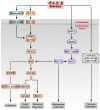The Molecular Mechanisms Associated with Aerobic Exercise-Induced Cardiac Regeneration
- PMID: 33375497
- PMCID: PMC7823705
- DOI: 10.3390/biom11010019
The Molecular Mechanisms Associated with Aerobic Exercise-Induced Cardiac Regeneration
Abstract
The leading cause of heart failure is cardiomyopathy and damage to the cardiomyocytes. Adult mammalian cardiomyocytes have the ability to regenerate, but this cannot wholly compensate for myocardial cell loss after myocardial injury. Studies have shown that exercise has a regulatory role in the activation and promotion of regeneration of healthy and injured adult cardiomyocytes. However, current research on the effects of aerobic exercise in myocardial regeneration is not comprehensive. This review discusses the relationships between aerobic exercise and the regeneration of cardiomyocytes with respect to complex molecular and cellular mechanisms, paracrine factors, transcriptional factors, signaling pathways, and microRNAs that induce cardiac regeneration. The topics discussed herein provide a knowledge base for physical activity-induced cardiomyocyte regeneration, in which exercise enhances overall heart function and improves the efficacy of cardiac rehabilitation.
Keywords: aerobic exercise; cardiomyocyte; molecular mechanism; regeneration; signaling pathways.
Conflict of interest statement
The authors declare no conflict of interest.
Figures


References
-
- Benjamin E.J., Muntner P., Alonso A., Bittencourt M.S., Callaway C.W., Carson A.P., Chamberlain A.M., Chang A.R., Cheng S., Das S.R., et al. Heart disease and stroke statistics-2019 update: A report from the American Heart Association. Circulation. 2019;139:e56–e528. doi: 10.1161/CIR.0000000000000659. - DOI - PubMed
-
- Ponikowski P., Voors A.A., Anker S.D., Bueno H., Cleland J.G., Coats A.J., Falk V., Gonzalez-Juanatey J.R., Harjola V.P., Jankowska E.A., et al. 2016 ESC Guidelines for the diagnosis and treatment of acute and chronic heart failure: The Task Force for the diagnosis and treatment of acute and chronic heart failure of the European Society of Cardiology (ESC). Developed with the special contribution of the Heart Failure Association (HFA) of the ESC. Eur. J. Heart Fail. 2016;18:891–975. doi: 10.1002/ejhf.592. - DOI - PubMed
-
- Seferovic P.M., Polovina M., Bauersachs J., Arad M., Gal T.B., Lund L.H., Felix S.B., Arbustini E., Caforio A.L.P., Farmakis D., et al. Heart failure in cardiomyopathies: A position paper from the Heart Failure Association of the European Society of Cardiology. Eur. J. Heart Fail. 2019;21:553–576. doi: 10.1002/ejhf.1461. - DOI - PubMed
-
- Pinto Y.M., Elliott P.M., Arbustini E., Adler Y., Anastasakis A., Bohm M., Duboc D., Gimeno J., de Groote P., Imazio M., et al. Proposal for a revised definition of dilated cardiomyopathy, hypokinetic non-dilated cardiomyopathy, and its implications for clinical practice: A position statement of the ESC working group on myocardial and pericardial diseases. Eur. Heart J. 2016;37:1850–1858. doi: 10.1093/eurheartj/ehv727. - DOI - PubMed
Publication types
MeSH terms
Grants and funding
- 81271410/National Natural Science Foundation of China/International
- 182300410313/Henan Science and Technology Development Project/International
- 192102310023/Henan Science and Technology Development Project/International
- 192102310024/Henan Science and Technology Development Project/International
- 19A890001/Science and Technology Key Project, Department of Education of Henan/International
LinkOut - more resources
Full Text Sources
Medical

